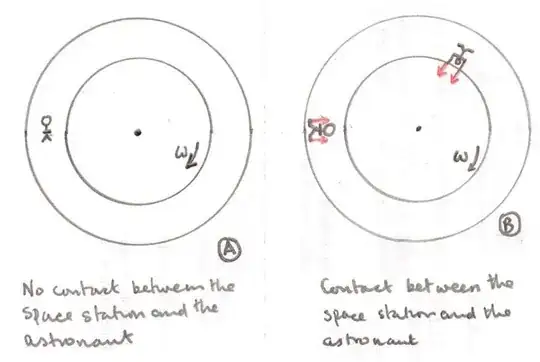This is a really nuanced issue, but it is not the spinning space station that "causes" the centrifugal force, but the spinning frame of reference. We begin to say things like "he feels a centrifugal force on him" at a point where the *best reference frame to describe his motion is a rotating frame.
You can model a system like your astronaut and a cylinder in any reference frame you please. That's one of the fundamental rules of how we model physics. You can even model your astronaut in a coordinate system consisting of North, East, and Down from the point of view of an observer on the ground watching the two fly by, and physics will still predict their motion accurately.
If you model it in an "inertial" frame, the motion will be described by the traditional Newtonian equations of motion (barring anything exotic like relativity, which will have a minimal effect at the speeds you are talking about). Objects will move in straight lines unless affected by a force from another object, like gravity or from contact with the surface of the cylinder. This is even true on rotating space stations! You can describe the motion of astronauts in a rotating space station without centrifugal forces if you describe their position in an inertial frame (such as ECI).
However, there's a catch here. The equations of motion may not be simple in such an inertial frame. Yes, you get rid of the centrifugal forces; you'll end up with some normal forces if they are standing on the inner surface of the cylinder. However, rotational motion like that means you're going to have to bring in all sorts of sine and cosine terms to describe the motion. The effect of the astronaut on the space station will be small but it may be remarkably hard to prove it is small, leading you to have to consider things like the space station wobbling about its axis.
In such a rotating situation, it can be more convenient to use a rotating frame of reference -- in this case, one attached to the space station or cylinder. When we do this, we get to avoid all of those sine and cosine terms because they end up getting bundled up into the motion of our frame. The math becomes tractable.
There's a price to pay for such rotating frames: centripetal forces and Coriolis effects. The laws of motion defined by Newton are for "inertial" frames, which are non-rotating. If you attempt to apply them in rotating frames, you get the wrong result. For a real life example, go to a playground with a ball and find a roundabout.

Get two people, put them on opposite sides of the roundabout while it isn't spinning, and have them toss the ball back and forth. This will work as expected. Now start spinning the roundabout and toss the ball back and forth. The people on the roundabout will observe the ball curving away from them at a right angle to its motion. Those on the ground will simply see the ball moving straight, and the people rotating out of its way. I can't link a gif here, but Wikipedia has a nice little gif showing this effect.
These odd effects come because the reference frame is rotating. If you dig into them with calculus, you discover that the equations of motion have some extra terms in them due to the continuously changing coordinate system. The first of these is the centripetal term, which has the appearance of a center-fleeing force. The second is the Coriolis term, which affects moving bodies at right angles to their motion, and is responsible for a great deal of the weather patterns we see on Earth. (note: I switched from centrifugal force to centripetal. The actual effect, when written in math form, is better described by a centripetal acceleration term, which goes towards the center. The centrifugal force is the effect is actually the "equal and opposite reaction" to the centripetal accelerations.)
These forces are often called "ficticious" forces, because they're not being caused by anything in the system. They're being "caused" by the mathematics of the rotating frame you chose. Simply put, in a rotating frame, the "correct" equations of motion include terms that don't appear in an inertial frame.
So in your example, we can view the astronaut and cylinder two ways. We can treat it with an inertial frame of reference or a rotating frame of reference. In the inertial frame, the astronaut and the cylinder are simply flying along in straight lines, decoupled. The cylinder has a few sines and cosines in its equations because it is rotating, but the astronaut does not. If we choose the rotating frame instead, we find the cylinder's motion is simple (it isn't moving with respect to our frame), but the astronaut will appear to be rotating at great speed around the central axis of the cylinder. Why? Because the astronaut isn't rotating with the cylinder, so as the frame of reference rotates around him/her, it will appear as though the astronaut is rotating. The exact equations of motion describing this astronaut in this rotating system will include a centripetal acceleration term which will ensure the astronaut is continuously accelerating towards the central axis just right to keep him/her on a circular orbit. In this case, we will find that both approaches describe the motion of the astronaut correctly, but the inertial case is much simpler looking.
However, let's change the situation a bit. Let's let the astronaut interact with the cylinder more. Let's either let them hold onto the surface, or fill the cylinder full of air (which will start rotating, as friction with the outer surface takes hold). Now the equations of motion are not so simple in the inertial frame. You have all of these extra forces to account for, each with ugly sine and cosine terms because they're all rotating. The equations get extremely messy in the inertial frame, but you do get the right answer.
Change to a rotating frame, and those complications go away. The air is (roughly) motionless, and the cylinder is motionless. The forces on the astronaut are much easier to write down now. Most of them even go away! However, we pay a price. The price of using a rotating frame is that the equations of motion for a rotating frame must include centripetal and Coriolis terms. You end up with the exact same result as you would have with the inertial frame, just with less mathematical pain and agony.
In many cases, handling these "fictitious forces" is easier than handling the forces that one has to include for an inertial frame of reference. Choose the right reference frame, and you cancel out as many of the ugly details as possible, leaving only an easy to solve equation!

